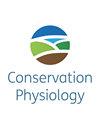Intake and growth histories modulate bone morphology, microarchitecture, and mineralization in juvenile green turtles (Chelonia mydas)
IF 2.6
3区 环境科学与生态学
Q2 BIODIVERSITY CONSERVATION
引用次数: 0
Abstract
Compensatory growth (CG) is accelerated growth that occurs when food availability increases after food restriction. This rapid growth may be associated with sublethal consequences. In this study, we investigated the effects of food restriction and subsequent realimentation and CG on bone structure in juvenile green turtles (Chelonia mydas). Turtles were fed ad libitum food for 12 weeks (AL), restricted food for 12 weeks (R), or restricted food for 5 weeks followed by ad libitum food for 7 weeks (R-AL). R-AL turtles demonstrated partial CG via enhanced food conversion efficiency (FCE) upon realimentation. After the 12th week, gross morphology (GM), microarchitecture, and mineralization of the right humerus of each turtle were analyzed. Many GM measurements (including proximal and maximal bone lengths, bone widths, and shaft thickness), most measurements of bone microarchitecture (excluding cortical and trabecular thickness and trabecular separation), and all mineralization measurements were labile in response to intake. We examined the possibility that changes in nutrient allocation to bone structure during realimentation facilitated CG in previously food-restricted turtles. Restoration of bone lengths was prioritized over restoration of bone widths during CG. Furthermore, restoration of trabecular number, connectivity density, and bone volume fraction was prioritized over restoration of cortical bone volume fraction. Finally, diaphyseal bone mineralization was partially restored, whereas no restoration of epiphyseal bone mineralization occurred during CG. Shifts in nutrient allocation away from certain bone attributes during food restriction that were not rectified when food availability increased probably provided an energy surplus that enhanced the conversion of food to growth and thus powered the CG response. Our study revealed how resource allocation to various bone attributes is prioritized as nutritional conditions change during development. These “priority rules” may have detrimental consequences later in life, indicating that conservation of green turtle foraging grounds should be given high priority.摄入量和生长历史调节绿海龟幼体的骨骼形态、微结构和矿化程度
补偿生长(Compensatory Growth,CG)是指在食物限制后,当食物供应增加时出现的加速生长。这种快速生长可能与亚致死后果有关。在这项研究中,我们调查了食物限制以及随后的食物恢复和补偿性生长对幼年绿海龟(Chelonia mydas)骨骼结构的影响。我们分别给绿海龟自由进食 12 周(AL)、限食 12 周(R)或限食 5 周后再自由进食 7 周(R-AL)。R-AL龟在进食后通过提高食物转化效率(FCE)表现出部分CG。第 12 周后,对每只乌龟右肱骨的大体形态(GM)、微结构和矿化情况进行了分析。许多 GM 测量值(包括近端和最大骨长、骨宽和骨干厚度)、大多数骨微结构测量值(不包括皮质和骨小梁厚度以及骨小梁分离度)以及所有矿化测量值都会随着摄入量的增加而发生变化。我们研究了一种可能性,即在静养期间,骨骼结构的营养分配发生了变化,从而促进了之前食物受限的海龟的骨骼生长。骨骼生长过程中,骨骼长度的恢复优先于骨骼宽度的恢复。此外,骨小梁数量、连接密度和骨体积分数的恢复优先于皮质骨体积分数的恢复。最后,骺端骨矿化得到了部分恢复,而骺端骨矿化在 CG 期间没有恢复。在食物限制期间,某些骨骼属性的营养分配发生了转移,而当食物供应量增加时,这种转移并没有得到纠正,这可能是能量过剩造成的,能量过剩促进了食物向生长的转化,从而推动了钙化反应。我们的研究揭示了在发育过程中,随着营养条件的变化,对各种骨骼属性的资源分配是如何进行优先排序的。这些 "优先规则 "可能会对以后的生活产生不利影响,这表明应高度重视绿海龟觅食地的保护。
本文章由计算机程序翻译,如有差异,请以英文原文为准。
求助全文
约1分钟内获得全文
求助全文
来源期刊

Conservation Physiology
Environmental Science-Management, Monitoring, Policy and Law
CiteScore
5.10
自引率
3.70%
发文量
71
审稿时长
11 weeks
期刊介绍:
Conservation Physiology is an online only, fully open access journal published on behalf of the Society for Experimental Biology.
Biodiversity across the globe faces a growing number of threats associated with human activities. Conservation Physiology will publish research on all taxa (microbes, plants and animals) focused on understanding and predicting how organisms, populations, ecosystems and natural resources respond to environmental change and stressors. Physiology is considered in the broadest possible terms to include functional and mechanistic responses at all scales. We also welcome research towards developing and refining strategies to rebuild populations, restore ecosystems, inform conservation policy, and manage living resources. We define conservation physiology broadly and encourage potential authors to contact the editorial team if they have any questions regarding the remit of the journal.
 求助内容:
求助内容: 应助结果提醒方式:
应助结果提醒方式:


